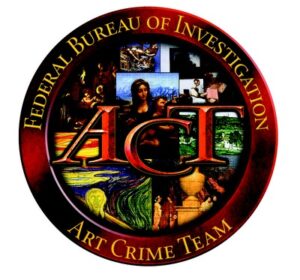Oh, YES! Searching two definitive sources for artworld news, this article compiles stories found recently on ArtNetNews, headquartered in NYC, and The Art Newspaper, with offices in NYC and London.
First, FORGERIES!
 The hot gossip: “DB,” a good artist, just not good enough to make a million selling his own artwork, ‘learns’ to make OTHER artist’s artworks in a secret hide-out in the middle of no-where.
The hot gossip: “DB,” a good artist, just not good enough to make a million selling his own artwork, ‘learns’ to make OTHER artist’s artworks in a secret hide-out in the middle of no-where.
This story is as old as time. One of my favorite books, Three Picassos Before Breakfast: Memoir of an Art Forger’s Wife by Anne-Marie Stein, tells the story of 1970s David Stein, a great masterpiece forger unmasked by none other than Marc Chagall. Donald “DB” Henkel, a good forger, who works out of his barn on a farm near Traverse City, Michigan, fell under scrutiny by the FBI’s Art Theft Crime Unit.
In less dishonest days, DB became known to the Grand Rapids contemporary art community. He entered art competitions, and created a sculpture for a local shopping mall. In 2005 he discovered a certain style of American Art which flourished in the 1930-40s. DB found he could “paint” in that style wonderfully well. So, he did, selling the masterworks of three artists of that period at auction, sometimes garnering $300K a canvas. DB forged works in this simple representational style; bold, colorful geometric compositions with clean outlines, as described in ArtNetNews.
A leading gallery duped into purchasing one of his paintings, Hirschl + Adler, NYC, called the purchase “every dealer’s nightmare.” The work appeared so good whoever did it must be an accomplished artist.
In a hot Midwestern summer raid in 2020
The FBI brought thirty agents to the remote Henkel barn. They found art supplies, ‘modified’ paintings, possible forgeries, and, surprisingly, sports equipment. Baseball bats?
Records showed DB sold a $60K “autographed” “Babe Ruth” bat, as well as a $120K “Lou Gehrig” bat. He sold “Original paintings,” and famous bats, allegedly signed by such as Honus Wagner and Cy Young. Diversification is the key: a photo accompanying this story on ArtNetNews shows DB’s barn’s worktable with an “original” Mickey Mouse drawing, and “Walt’s” signature.
In the Henkel case, he used acyclic paints to forge a few paintings, and those weren’t used commercially for fine art until the 1950s. Busted!
In Other Forgery Cases
The FBI’s Art Theft Crime Team uses more advanced “gotcha” methods, such as wire fraud, when a work is sold with a forged signature of authenticity via email.
The biggest Art Crime case of many centuries is perhaps the sad story of Inigo Philbrick, recently (May 23, 2022) sentenced to seven years and now owes former clients $86M. Last November, he pleaded guilty to a criminal charge of wire fraud and spent the past two years in jail. A US District Court found the former Art Market golden boy (now 35) sold shares in certain works of art to various multiple owners, each holding in some cases MORE than a hundred percent. Philbrick sold art he didn’t own, forged signatures, wrote false contracts, and invented competition “clients,” while living the high life internationally, says ArtNetNews.
In 2020 under pressure from civil lawsuits, Philbrick took off for a small island in the South Pacific, where the FBI met his plane.
Yes, he agreed to restitution of $86M but many of his own high value paintings are in ownership disputes. So investors, such as Fine Art Partners, are suing him individually for $13M in lost art.
Artworld HOT TOPIC:
Russian Art Collectors Now Targeted by “KleptoCapture!”
A new (2020) US Department of Justice Squad, “KleptoCapture,” headed by Andrew Adams, a NY veteran Federal Prosecutor specializing in Russian organized crime, is a special interagency task force empowered to assist in the seizure of art and assets from Russian oligarchs. Fine art is the NEW ‘hedge’ investment against a rocky economy. Russian oligarchs don’t necessarily buy works of art, but their SHELL companies DO. As tangible assets, such as mansions ‘disappear,’ they can hide art “stored” in “in-between” places such as freeports and megayachts.
Oleg Deripaska was sanctioned in 2018 for laundering money for Vladimir Putin. According to Forbes, as quoted in ArtNetNews, Deripaska has a net worth of $3.1 Billion. Oleg Deripaska recently “lost” a Diego Rivera painting, a Washington DC mansion, a NYC townhome, Prada shoes, collectible baseball, and other precious things.
Another Russian Oligarch
=Roman Abramovich, “lost” a $120M mansion on the French Riviera, seized by the French government in April of 2022. Until 1950 the Duke and Duchess of Windsor owned the mansion built in 1927, and after by Aristotle Onassis.
Abramovich, an art magnate, founded Moscow’s Garage Museum of Contemporary Art in 2008. The UK forced Abramovich to sell his Chelsea Football Club.
France actively seizes Russian assets (mansions, art, yachts, helicopters) up to $27 Billion at this point, according to ArtNetNews. But a sanctioned Russian oligarch last month bought a $6M painting under his shell company’s name.
The Art Market reflects our national ethical/consumer culture, and echoes international tensions, whether it be art “made” in a Michigan barn, art sold by a wily charismatic NYC dealer (think of 200% ownership shares of a certain Broadway play in Mel Brooke’s “The Producers”), or seizures of Russian oligarchs’ art by the FBI and KleptoCulture; yet, as crazy as the world is now, the artworld is crazier.